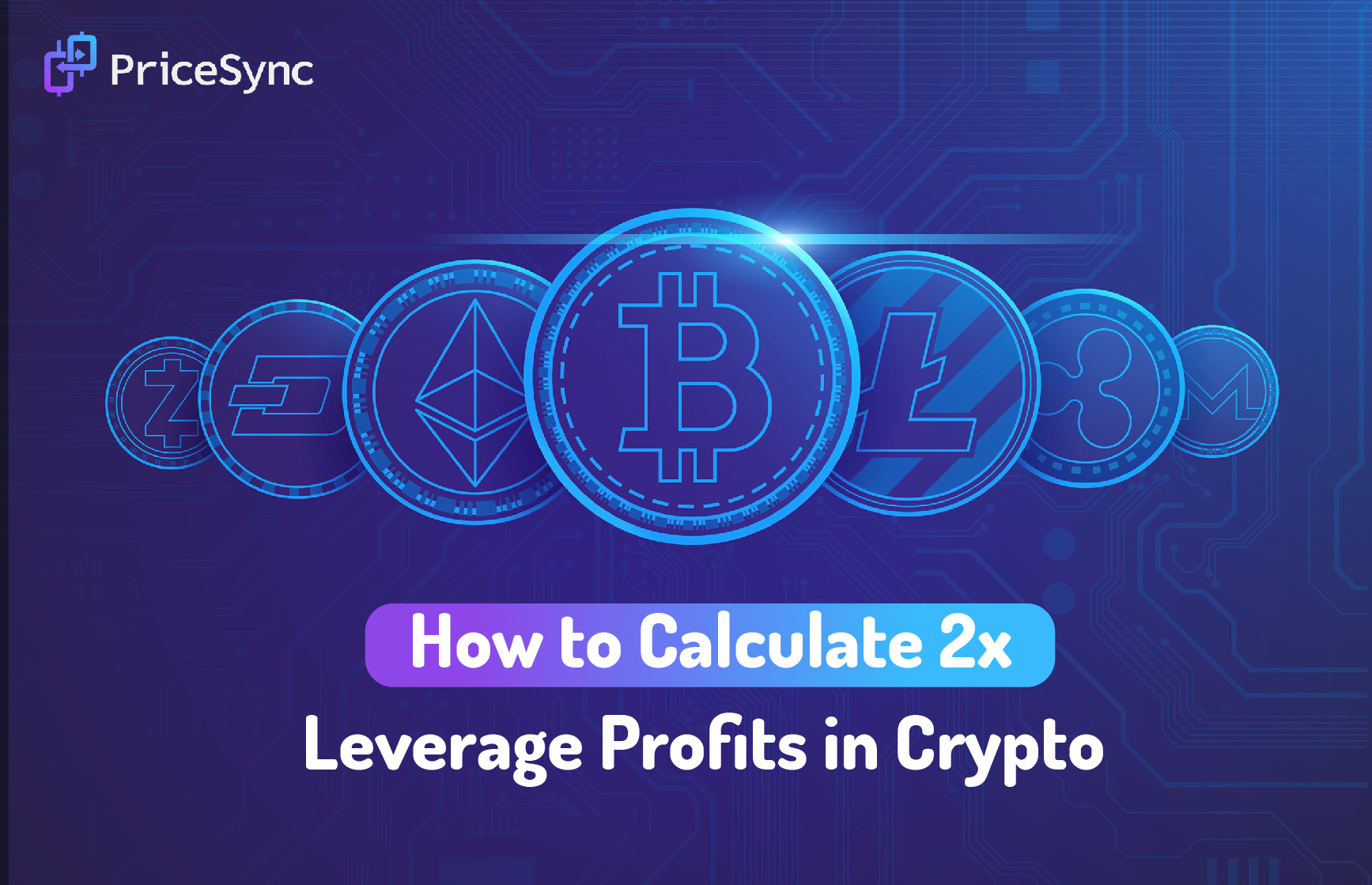
Calculating profits in crypto trading isn't as simple as it looks. The market’s high volatility, constant price swings, and advanced tools like margin and leverage make it more complex. Unlike traditional assets, crypto prices can fluctuate by 10-20% within hours, making precise profit calculations essential.
Frequent trades, hidden fees, and varying exchange rates further impact your actual earnings. Using 2x leverage doubles your potential profits and magnifies losses, requiring careful strategy. Studies show that traders who accurately track ROI, net profit margin, and break-even prices improve profitability by 30%.
At PriceSync, we simplify trading with expert price action analysis and daily chart setups, helping you make more informed decisions. On this page, you'll learn how to calculate 2x leverage profits in crypto, understand key profit metrics, and use the right tools to maximize your gains.
Understanding the Basics of Profit Calculation
Crypto profit calculation is all about figuring out how much you earn or lose when you buy and sell cryptocurrencies. It’s important because it helps you track your trades' performance.
To calculate your crypto profit, you need to consider the following:
Entry Price – This is the price you pay when buying cryptocurrency.
Exit Price – This is the price you get when selling cryptocurrency.
Quantity – This is the amount of cryptocurrency you buy or sell.
Fees – These are the costs involved in buying or selling, like transaction fees and commissions.
Here’s the simple formula to calculate your profit:
Profit = (Selling Price - Buying Price) × Quantity - Fees.
Example:
Suppose you bought 1 Bitcoin at $20,000 and sold it at $22,000. Your transaction fees were $100.
Now, applying the formula:
Profit = ($22,000 - $20,000) × 1 - $100
Profit = $2,000 - $100
Profit = $1,900
So, in this example, your profit is $1,900 after buying and selling 1 Bitcoin.
Why This Matters:
Calculating your profits helps you see how well your trades are performing. For example, if you make a 10% profit on your investment, this means for every $1,000 you invest, you earn $100. If your investment grows to $10,000, your profit will be $1,000. This calculation is important to see if you're making the right trade decisions.
Knowing how to calculate profits will also help you with risk management. If you understand how much you’re earning or losing, you can adjust your trades to improve your overall profitability.
Key Profit Metrics Crypto Traders Care About
Crypto traders use a variety of metrics to understand how well they’re doing. These metrics help you see if your trades are making money and how efficient your strategies are. Here are the top profit metrics you should know:
1. Return on Investment (ROI)
This tells you how much profit you made compared to what you invested. It’s a quick way to check if your trade was worth it.
Formula: ROI = (Profit / Investment) × 100
For example, if you spent $1000 on a trade and earned $200, your ROI would be:
ROI = (200 / 1000) × 100 = 20%
20% ROI means you made 20% profit on your initial investment.
2. Profit and Loss (PnL)
PnL tracks your gains and losses from trades. It’s one of the most important metrics because it shows your net earnings.
Formula: PnL = (Exit Price - Entry Price) × Quantity - Fees
Example: If you bought a coin at $100 and sold it at $120, and you bought 10 coins with $10 fees, the calculation is:
PnL = (120 - 100) × 10 - 10 = $200
Your profit would be $200 after all fees.
3. Net Profit Margin
This tells you how much profit you made after covering all the costs, including fees. A higher margin means you’re keeping more of your earnings.
Formula: Net Profit Margin = (Net Profit / Revenue) × 100
For example, if your net profit was $200 and your revenue was $1000, your net profit margin would be:
Net Profit Margin = (200 / 1000) × 100 = 20%
A 20% margin means you kept 20% of your total revenue as profit.
4. Break-even Price
This is the price at which you neither gain nor lose money. Knowing this price is crucial so you can avoid losing money on a trade.
Formula: Break-even Price = (Entry Price + Fees) / Quantity
If you bought a coin at $100 and paid $10 in fees for 10 coins, your break-even price would be:
Break-even Price = (100 + 10) / 10 = $11
You need the price to rise above $11 to start making a profit.
5. Sharpe Ratio
The Sharpe Ratio helps you understand if the returns you’re getting are worth the risk. A higher ratio means you’re making better returns for less risk.
Formula: Sharpe Ratio = (Average Return - Risk-Free Rate) / Standard Deviation of Returns
For example, if you earned 20% returns, the risk-free rate was 5%, and your standard deviation was 10%, your Sharpe Ratio would be:
Sharpe Ratio = (20% - 5%) / 10% = 1.5
A Sharpe ratio of 1.5 means you earned 1.5 times the return for each unit of risk.
6. Annualized Return
This shows how much your investment has grown over the years. It helps compare the performance of different assets over time.
Formula: Annualized Return = (1 + Total Return) ^ (1 / Years) - 1
Example: If you made a total return of 50% over 6 months, your annualized return would be:
Annualized Return = (1 + 0.50) ^ (1 / 0.5) - 1 = 100%
Your annualized return is 100%, meaning if your performance continues, you’ll double your investment in one year.
7. Win Rate
This is the percentage of successful trades you’ve made. A high win rate shows that your strategy is working well.
Formula: Win Rate = (Number of Winning Trades / Total Trades) × 100
Example: If you made 80 winning trades out of 100, your win rate would be:
Win Rate = (80 / 100) × 100 = 80%
An 80% win rate means you’re winning most of your trades, which indicates a solid strategy.
8. Drawdown
Drawdown measures how much your portfolio has fallen from its highest point. It shows how risky your trading is and helps you assess potential losses.
Formula: Drawdown = (Peak Value - Lowest Value) / Peak Value
Example: If your portfolio peaked at $10,000 and dropped to $7,000, the drawdown would be:
Drawdown = (10,000 - 7,000) / 10,000 = 30%
A 30% drawdown means your portfolio lost 30% of its value from its peak, which could signal high risk.
What is 2x Leverage in Crypto Trading?
2x leverage allows you to double your trading position using borrowed funds from the exchange. If you have $1,000, you can open a $2,000 trade. This increases your potential profit, but it also doubles your losses if the market moves against you. Leverage trading is common in crypto markets, with over 50% of traders using leverage to increase their exposure. However, 60% of them lose money due to poor risk management.
How 2x Leverage Works
When using 2x leverage, you borrow funds to trade a larger position than your actual investment. The exchange provides 50% of your trade value as a loan, and you are responsible for repaying the borrowed amount and any fees.
Higher Gains: If the market moves in your favor, your profit is doubled compared to a regular trade.
Higher Risks: If the market moves against you, your losses are also doubled. If the price falls too much, you may face liquidation, losing your entire initial investment.
Most crypto exchanges require a minimum margin, meaning if your losses reach a certain level, your trade is automatically closed to prevent further losses. Over 80% of liquidations in the crypto market occur due to high-leverage trading.
Example of a 2x Leveraged Trade
To understand how 2x leverage works, consider this example:
Scenario: You trade Bitcoin (BTC) with 2x leverage
Your Capital: $1,000
Leverage Used: 2x
Total Trade Size: $2,000 (your $1,000 + $1,000 borrowed)
Bitcoin Entry Price: $40,000 per BTC
Amount Bought: 0.05 BTC
If the BTC price increases by 10% (to $44,000)
Without leverage: Your profit = $100 (10% of $1,000)
With 2x leverage: Your profit = $200 (10% of $2,000)
If the BTC price drops by 10% (to $36,000)
Without leverage: Your loss = $100
With 2x leverage: Your loss = $200
If Bitcoin drops 50% to $20,000, your entire $1,000 investment is lost, and the exchange will liquidate your position to recover the loaned funds.
Formula to Calculate 2x Leverage Profits
Profit=(Exit Price−Entry Price)×Position Size×Leverage−Fees
Step-by-Step Breakdown:
Entry Price – The price at which you buy the crypto asset.
Exit Price – The price at which you sell the asset.
Position Size – The number of units of the asset you trade.
Leverage – The multiplier applied to your position (2x in this case).
Fees – Trading fees, funding rates, or any other charges deducted from your profit.
Example Calculation
Trade Details:
Crypto Pair: BTC/USDT
Entry Price: $30,000
Exit Price: $32,000
Position Size: 0.5 BTC
Leverage: 2x
Trading Fee: 0.1% per trade
Step 1: Calculate Gross Profit
Profit = (32,000 - 30,000) × 0.5 × 2
Profit = (2,000) × 1
Profit = 2,000 USD
Step 2: Deduct Trading Fees
Trading fee per trade = 0.1% of trade value
Fee = (30,000 × 0.5 × 2) × 0.001 + (32,000 × 0.5 × 2) × 0.001
Fee = (30,000) × 0.001 + (32,000) × 0.001
Fee = 30 + 32
Fee = 62 USD
Step 3: Net Profit
Net Profit = Entry Price - Exit Price
Net Profit = 2,000 - 62
Net Profit = 1,938 USDT
Final Profit Summary:
Gross Profit: $2,000 USD
Total Trading Fees: $62 USD
Net Profit After Fees: $1,938 USDT
This example shows how leverage amplifies profits but also increases costs like trading fees and liquidation risks. Always calculate profits carefully and use risk management strategies to avoid unnecessary losses.
Factors That Affect 2x Leverage Profits
Several factors directly influence your profits and losses in leveraged trading. These include fees, market volatility, and liquidation risks. Here’s how they impact your profits:
Trading Fees and Funding Rates
Trading fees and funding rates can reduce profits by up to 1-5% per trade, depending on the platform. High fees can quickly add up, especially in frequent trades. Funding rates for holding positions overnight may vary, costing up to 0.1-0.5% daily.
Market Volatility and Slippage
Market volatility can cause slippage that may affect your trade by 0.5-2% per position. When using leverage, even small price movements can result in large profit swings or losses. Volatility can also amplify potential gains by 50-100% but increases the risk of significant losses.
Liquidation Risk in Leveraged Positions
With 2x leverage, a 10-20% market move against your position could trigger liquidation, meaning a complete loss of your investment. Always monitor positions to prevent liquidation, especially in highly volatile markets.
Why Risk Management is Crucial
Effective risk management can reduce potential losses by 20-30%. Using tools like stop-loss orders, position sizing, and profit targets minimizes risk, keeping your capital protected while maximizing returns.
Tips for Trading Safely with 2x Leverage
When trading with 2x leverage, applying some best practices to minimize risk and protect your profits is essential. Here are some key tips to help you trade safely and effectively:
Stop-Loss Placement
One of the most important risk management tools in leverage trading is the stop-loss. Always set a stop-loss to limit your potential losses in case the market moves against you. By doing this, you can control risk and prevent large losses from wiping out your position.
Position Sizing
Position sizing refers to how much of your capital you're willing to risk on a single trade. For 2x leverage, it's crucial to size your positions carefully. Avoid risking too much of your capital on one trade to risk only a small percentage (e.g., 1-2%) per trade. This helps to protect your portfolio from significant downturns.
Avoid Over-Leverage
While 2x leverage can amplify gains, it also increases the potential for loss. Over-leveraging (using more leverage than you can handle) can be risky and lead to liquidation if the market moves against you. Stick to 2x leverage or lower until you're comfortable with the market and the risks involved.
Proper Market Analysis
Conduct thorough market analysis before entering any leveraged trade. Make sure you're aware of the market trends, support/resistance levels, and any potential news that might affect the market. Technical analysis and price action charts are great tools for evaluating trends and making informed decisions.
Risk Assessment
Before opening a trade, assess the risk-to-reward ratio. This means understanding how much you could lose versus how much you could gain. Aim for a risk-to-reward ratio of at least 1:2-where your potential reward is twice the amount you're risking. This ensures that even if you lose a few trades, your profits from winning trades will outpace the losses.
Start Small and Scale Up Gradually
If you're new to leveraged trading, start with small positions and gain experience. As you build confidence and understand the market dynamics, you can increase your position size gradually. This approach helps you manage risks without exposing yourself to huge losses early on.
Final thoughts
In conclusion, knowing how to calculate 2x leverage profits in crypto is crucial for any trader looking to amplify their gains while managing risk. By understanding the basic formula and using the right tools, you can make smarter trading decisions and optimize your profits. But remember, leveraged trading can be a double-edged sword – it’s essential to balance potential rewards with careful risk management.
At PriceSync, we provide daily chart setups and expert analysis to help you stay in sync with market conditions and master the art of price action trading. Whether you're a seasoned trader or just starting, our insights will guide you every step of the way.
Are you ready to take control of your crypto trading success and boost your profits with 2x leverage? Let’s dive into PriceSync and refine your strategies today!


 Crypto Trading
Crypto Trading 08:10 AM
08:10 AM
Leave a Comment: